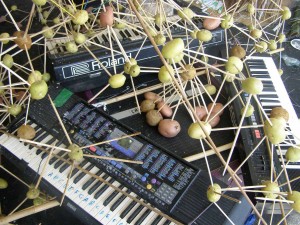Considerations of the rumbling tenor of his prose aside, the name of German philosopher Martin Heidegger is not one usually associated with speculations on sound, or even to listening. Hegel, Husserl and Derrida are much better known for pondering the relationship of the ear to metaphysics, debating, for example, whether the closed-circuit listening in on your own private acts of thinking is the ultimate legitimation of subjecthood and self-presence. Heidegger had no interest in such solipsistic projects. Rather he’s the philosopher attuned to listening in on the everyday day and the chatter of so-called idle talk.
A philosopher of non-imposition upon the world of things, Heidegger’s mode of philosophy is to listen and to wait. His name hangs somewhat as a cipher for a mode of engagement, synonymous with the ‘letting be’ of things to do their own thing. In what is perhaps his most famous essay, ‘The Origin of the Work of Art’ (1935), he cautioned against the artist’s imposition on the world of things, famously relegating the artist to the position of ‘waiting upon the thing’. Thirty years ahead of Alan Kaprow he championed art’s ‘happening’ as a way of being with things. [1]

Dylan Martorell, Stolon Tonals (detail), 2008, multimedia installation including foreground work in close-up, Stolon Arcology (with potatoes, chopsticks, keyboards). Image courtesy the artist. Photograph by Dylan Martorell.
So what would one expect of three sound works for Heidegger? Of the semi-transparent antenna of copper windings of Joyce Hinterding’s aeriology , Mark Brown and the O’Connor brothers’ stuttering autofocus automata, Desertion, or Dylan Martorell’s staggering fractal tower of raw potatoes and chopsticks weighing upon a base of keyboards in Stolon Tonals, none were specially commissioned or conceived with Heidegger in mind. Yet all are characterised by a certain relationship of non-imposition, of ‘letting be’, in their engagement with the sonic capacities of materials and phenomena. In respect of the active nature of the installations the artist is less a maker/creator than a co-conspirator whose role is one of working with, or ‘being-alongside’. In a gesture that’s close to self-erasure the artists seemingly step aside to make way for the work to self-realise.
[For more, read the special Arts of Sound November 2009 Issue of Art Monthly Australia www.artmonthly.org.au]
Ann Finegan
Anne Finegan teaches Film and Digital Arts at Sydney College of the Arts.
Footnote
[1] Martin Heidegger, ‘The Origin of the Work of Art’, in Poetry, Language, Thought, Harper-Colophon, New York, 1975, pp. 17-87.
 This work is licensed under a Creative Commons Attribution-NonCommercial-ShareAlike 2.5 Australia.
This work is licensed under a Creative Commons Attribution-NonCommercial-ShareAlike 2.5 Australia.






